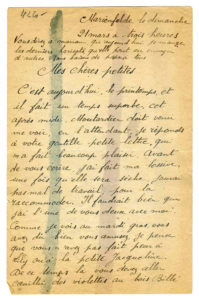 When Carolyn Porter purchased a handful of WWII-era letters she found in an antique store in Stillwater, MN, she imagined designing a cursive script font based on the beautiful penmanship. Never did she imagine the story behind them since she didn’t read French. She assumed they were love letters and spent countless hours creating an award-winning font before deciding to have one translated. A French man named Marcel Heuze, postmarked Berlin 1943, sent a letter to his wife and daughter in the countryside outside Paris. Porter begins to search for the fate of this French catholic metalworker conscripted under the Vichy regime by the Nazis to work in a Daimler factory at a labor camp.
When Carolyn Porter purchased a handful of WWII-era letters she found in an antique store in Stillwater, MN, she imagined designing a cursive script font based on the beautiful penmanship. Never did she imagine the story behind them since she didn’t read French. She assumed they were love letters and spent countless hours creating an award-winning font before deciding to have one translated. A French man named Marcel Heuze, postmarked Berlin 1943, sent a letter to his wife and daughter in the countryside outside Paris. Porter begins to search for the fate of this French catholic metalworker conscripted under the Vichy regime by the Nazis to work in a Daimler factory at a labor camp.
If you are interested in history, family stories, penmanship, letters, a dog named Hoover, a husband to hang onto, and tracking down the fate of the man who wrote the letters, you’ll enjoy reading Marcel’s Letters: A Font and the Search for One Man’s Fate. It’s become popular with book clubs across the Midwest since its release from Skyhorse in June 2017.
This work of narrative nonfiction won first place in the category of biography/autobiography/memoir at the 2018 Paris Book Festival and a 2018 Gold IPPY Award for Best First Book – Nonfiction, and a finalist for the Minnesota Book Award in Memoir/Narrative Nonfiction.
 Carolyn Porter lives in White Bear Lake, Minnesota, with her husband, Aaron, and their 110 lb. lap dog. She attended elementary school in Verona, Wisconsin, and graduated from UW-Stout.
Carolyn Porter lives in White Bear Lake, Minnesota, with her husband, Aaron, and their 110 lb. lap dog. She attended elementary school in Verona, Wisconsin, and graduated from UW-Stout.
You can hear Carolyn Porter speak on the first day of the festival, Monday, October 8, at 1:30 pm in the Kaukauna Public Library. Later that same day, she will be in Little Chute at the Gerard H. Van Hoof Memorial Library at 6:30 pm.
While World War II was fought in Europe against the Germans, we also fought in the Pacific theater against imperialist Japan. 
Inspired by finding an old shoe box in a closet after his mother’s death, containing war letters and POW cards, Adrian Martin began to research and write this biography of his uncle and name sake. His uncle died in a Japanese Prisoner of War Camp in 1945 after having been a prisoner for 3 1/4 years, including the infamous Bataan Death March.
 Based largely on primary materials, including a fifty-nine-page report written by the surviving unit members in September 1942, Operation PLUM (from the code name for the U.S. Army in the Philippines) gives an account of the 27th Bombardment Group and, through it, the opening months of the Pacific theater.
Based largely on primary materials, including a fifty-nine-page report written by the surviving unit members in September 1942, Operation PLUM (from the code name for the U.S. Army in the Philippines) gives an account of the 27th Bombardment Group and, through it, the opening months of the Pacific theater.
They went in as confident young warriors. They came out as battle-scarred veterans, POW camp survivors
. . . or worse. The Army Air Corps’ 27th Bombardment Group arrived in the Philippines in November 1941 with 1,209 men; one year later, only 20 returned to the United States.
The Japanese attacked the Philippines on the same morning as Pearl Harbor and invaded soon after. Allied air routes back to the Philippines were soon cut, forcing pilots to fight their air war from bases in Java, Australia, and New Guinea. The men on Bataan were eventually taken prisoner and forced into the infamous Death March.
You can hear Adrian Martin speak on Monday, October 8 at 2 pm in the Elisha D. Smith Menasha Public Library.






